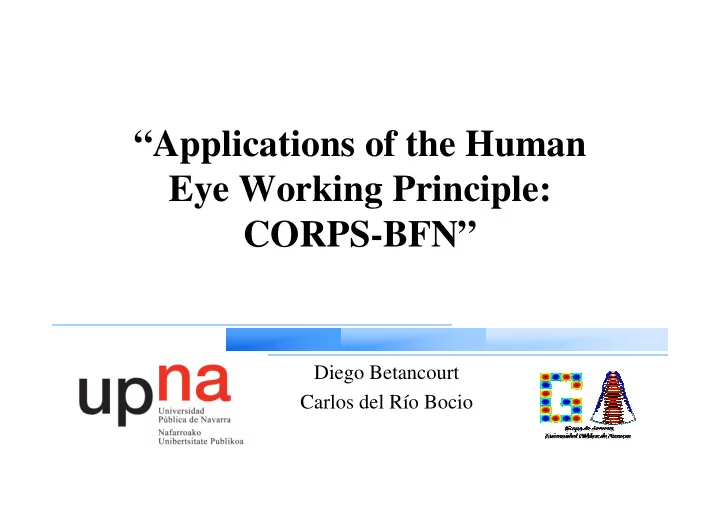

“Applications of the Human Eye Working Principle: CORPS-BFN” Diego Betancourt Carlos del Río Bocio
Human Eye – The photoreceptors at the Macula (cones) are 1.5 � m diameter and separated 0.5 � m. – Quasi regular hexagonal lattice – Visual acuity or angular resolution… 50 second of arc
Human Eye – This approximation shows some weak points: • What happens if the two sources are colored? The resolution should be significantly worst… • The Human Eye able to distinguish smaller details. • The Minimum Visible is similar to 1 second of arc . – Hyper-acuity is the common term used for this effect
Human Eye • How the hyper-acuity could be justified? – Additional effects in vision: • It is well known that the cones are – strongly coupled, increasing the signal noise ratio • Other factors, – light diffraction and – quick movements of the eye to avoid photoreceptors saturation, – All these effects create some “diffusion” of the images on the retina, despite being optically perfectly focused. – In other words, all the radiating areas of all the beams that the Human eye is able to distinguish are strongly overlapped.
Human Eye – An acceptable value for the Minimal Angle of Resolution (MAR) is 1 minute of arc – Equivalent to an uniformly illuminated circular aperture of 1 mm radius � Pupil!!! � � � R aper ( � � � � m) Angle D (dB) 1’ 80,99 1.086,14 – To have 1 degree well focused… only ONE lens used, and more than 360 approx. 360 beams (lenses) needed SIMULTANEOUS beams properly defined
Human Eye (BFN)
Introducing CORPS • The Coherently Radiating Periodic Structures (CORPS) work exactly as the human eye does, – coupling coherently (phase independent) to the surrounding elements of the array – controlling that coupling with the periodic disposition of the radiating elements
Coherently Radiating Periodic Structures • First idea � Consider the array as a periodic structure and use the mutual coupling smartly – All the elements are equally shaped and resonate at the same frequency
Coherently Radiating Periodic Structures • Second idea � Select the distance to have a coherent mutual coupling (an effective wavelength of the coupling mechanism) – The coupled power will be coherent (in phase), similarly as in the leaky wave antennas – Substrate wave modes could be used as a good coupling mechanism with planar antennas
Coherently Radiating Periodic Structures • Ensuring the coherent coupling between elements, a second harmonic Bragg structure is defined, so a rejecting filter will be automatically tuned…
Coherently Radiating Periodic Structures • Only the surrounding elements will couple some power!!! • The coupling is controlled.
CORPS-BFN • The mutual coupling sometimes could be difficult to control, and it is not as strong as we could need to improve the radiating performance. • But the same idea could be applied to the BFN…
CORPS-BFN • In transmission, a clear overlapping of the different beam could be defined at the radiating aperture • • Improving the angular resolution of the multibeam system
CORPS-BFN • In reception, the spatial diversity is applied: – Reduction of the complexity of the detectors (SNR) – A post-processing is required to obtain the information of each pixel – The image resolution (pixels) could even be improved 8 Detectors
Analogy with Human Eye Concluding : - CORPS-BFN as a possibility of control the coupling mechanism - Simple detectors - Simple post-processing Correlation - Robustness Interpolation Detectors RF Coupling
Fabricated CORPS-BFN Config. A Config. B Config. C Config. D
Recommend
More recommend